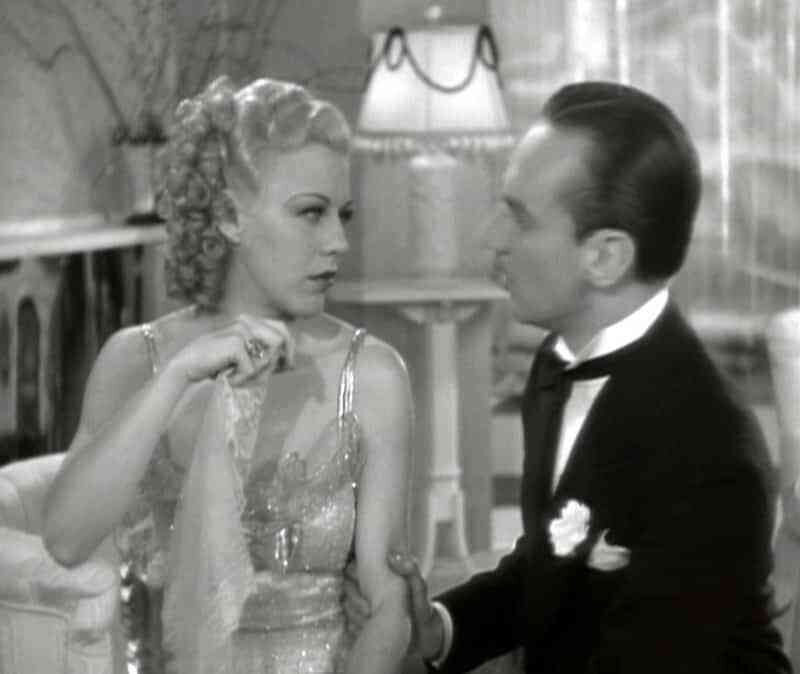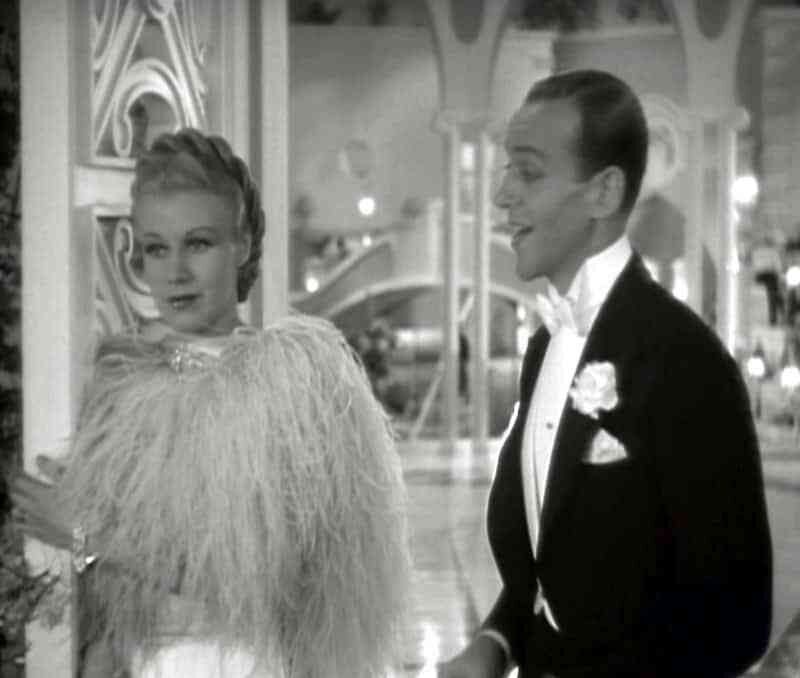Top Hat: Ginger Rogers' Ostrich Feather Dress | Clothes on Film – Part 14378
In 1935, Fred Astaire and Ginger Rogers made cinema history with their most successful film partnership, Top Hat. However, it wasn’t Astaire’s headgear that got people talking; it was Rogers’ ostrich feather dress worn in the Oscar-nominated song ‘Cheek to Cheek’.
The fact remains that this is quite possibly the most memorable, beautiful and romantic musical number ever captured on film, and Rogers’ dress contributes to this greatly.
Whenever Astaire and Rogers dance, they are making love without undressing, without even kissing in the majority of their films; “they is angels” remarks unfairly condemned criminal Kofi as he fulfils his dying wish of watching the lovers perform ‘Cheek to Cheek’ in the film The Green Mile (1999).
In this scene, Rogers certainly does look like an angel in her now-famous dress, accessorised only by a glass panel-style bracelet (costume jewellery in enamel or glass was very fashionable in the 1930s), probably satin single strap high-heeled ballroom dancing shoes (the taps you can hear were added after filming) and her hair unusually twisted around her head to a large bun at the nape of her neck in an almost virginal way. Her make-up is beautiful and not over-done, which again suggests an angelic quality.
The plots of many of the Astaire-Rogers films were great fun but mostly forgettable and farcical cases of mistaken identity, Top Hat being no exception. In this scene, Jerry Travers (Astaire) is pursuing Dale Tremont (Rogers), a model employed by an Italian fashion designer Beddini (Erik Rhodes) to wear his glamorous gowns where they could be seen by the upper classes; an extremely current storyline as this was a time when film stars would bring designer clothes to life for the general public.
However, unbeknown to Travers, Dale believes that he is married to her best friend, which of course he isn’t. Dale is regretfully completely in love with Jerry and is in complete turmoil, which brings great emotion and sadness to the number.
As Jerry sings to her, Dale is transfixed and is almost expressionless, save for a stunning close-up at the end of the ‘seduction’ which shows her eyes glistening with tears. Thankfully Rogers was to win an Academy Award for her acting skills five years later for the part of Kitty Foyle, sans Astaire.
Beginning slowly, with Rogers trying to resist Astaire’s advances initially, he persists to pull her into the dance, almost wrapping himself in her arms. The dress floats divinely as Rogers falls into a number of backbends which become progressively deeper throughout the number, the final one giving in completely to her partner. She has yielded.
In the depression of the 1930s, many cinemagoers wanted to escape from the daily grind, and through imagining that these characters spent every moment living in the lap of opulence wearing evening dress, they could spend a dreamy hour or two at the cinema believing in this regained glamorous innocence.
Hollywood leading ladies were expected to be a showcase for couturier’s work, and Ginger Rogers was no exception. Rogers was adamant she was wearing the dress she had designed along with Bernard Newman, who had created many of her stunning gowns in previous Astaire and Rogers outings. Apparently he would value Rogers’ suggestions, showing her samples of luxurious fabrics, and on this occasion he sketched as she told him her wishes.
Rogers required a “pure blue” dress like the blue in Monet paintings, appropriate as it had been said that she was the watercolour to Astaire’s sketches. Of course, with the film being shot in black and white the colour wasn’t seen by the audience, but for costume designers it was vital nonetheless that the shades were sympathetic to the set at RKO Studios.
The gown was to be made of figure-hugging shimmering satin and encircled with ostrich feathers around the neck and shoulders and from the hips downwards. An Art-Deco style diamond-shaped diamante jewel at the neckline and a satin bow at the bottom of the back completes the look.
Rogers’ desired shape is interesting and very typical of the era – her wish was for a high front and a low back. After the intoxicating craziness of the 1920s, the Hayes Censorship Code in 1932 called for women to cover up their cleavage and show as little flesh as possible. Ironically enough, the female form was thus more visible than ever, as bare backs became ‘de rigueur’, and therefore no bras were worn and evening gowns clung to the body provocatively.
The bias-cut, introduced by the revolutionary Madeleine Vionnet who discovered that material cut on the diagonal allowed dresses to echo the fluidity of a woman’s shape, is a hallmark of the 1930s and was perfect for dancers such as Rogers as these allowed audiences to not miss a moment of the movements of her body.
Ginger was enamoured with the dress immediately as she rehearsed with Fred for the first time in her gown, at which the crew had commented “Is it a bird? Is it a plane? No, it’s Ginger’s dress!”, and even Astaire’s wife Phyllis had commented to spectator David Niven “she looks like a wooster!” (meaning ‘rooster’ as she couldn’t say her r’s properly).
It was nonetheless perfect for dancing in, the feathers (which had been extended at a cost of $1, 500) floating stunningly as Rogers glides across the equally beautiful but not at all realistic ‘Venetian Canal’ Big White Set (BWS), in the style that designers Van Nest Polglaise and Carroll Clark had become accustomed to creating, this their biggest stage yet.
Unfortunately for Astaire, some of the feathers floated so much that they fluttered off the dress and onto his face, his ‘white tie and tails’, and the floor in a blizzard-like fashion, which can still be seen on film to this very day. Of course, a disgruntled Fred wasn’t having any of it and much to Rogers’ disappointment the next thing she heard was that director Mark Sandrich wanted her to wear a dress she had already worn in The Gay Divorcee (1934).
“Feathers. I hate feathers/And I hate them so that I can hardly speak/And I never find the happiness I seek/With those chicken feathers dancing/Cheek to Cheek.” sung to the tune of Irving Berlin’s ‘Cheek to Cheek’ was Astaire and choreographer Hermes Pan’s humorous way of showing their disdain at Rogers’s self-designed dress. The whole episode was obviously on Fred’s mind 24 years later in his autobiography ‘Steps in Time’, when he named one of the chapters ‘Feathers’.
Somewhat of a taskmaster, Astaire already had grave misgivings about the film’s script, so when the wardrobe mistress, Clarkie, walked across set with what Astaire immediately described as “a chicken that’d been attacked by a coyote”, this took the biscuit.
But thankfully, a threat by Rogers and her notoriously matriarchal mother Lela Rogers to walk out if the film unless they got their way won over their male counterparts and the dress was back in the film, albeit with the feathers now sewn firmly on!
There was a rather frosty reception from the cast and crew towards Rogers as the rushes were shown. However, after a few days she received a white box with a matching bow, the note saying “Dear Feathers, I love ya! Fred.” Inside was a gold feather for her charm bracelet:
This was Fred’s way of making amends, as while they were not bosom buddies (save for a quick petting session in the back of a car in the late 1920s!) they had the utmost respect for each other as professionals and Fred often said that Ginger was his favourite leading lady as she just got on with the job in hand instead of crying like his other partners. This didn’t stop Astaire parodying the number with a rival of Rogers, Judy Garland, in the film ‘Easter Parade’ 13 years later.
Ironically enough, in the 1970s Ginger Rogers fulfilled her costume-designing dream further as she became fashion consultant to the American chain ‘J.C. Penney’ (see image above) , creating a 20 piece wardrobe for 700 stores across the USA. And the infamous ostrich feather dress? It resides at the Smithsonian Institution, Washington DC. And not a stray feather to be found.
© 2010 – 2014, Lord Christopher Laverty.









